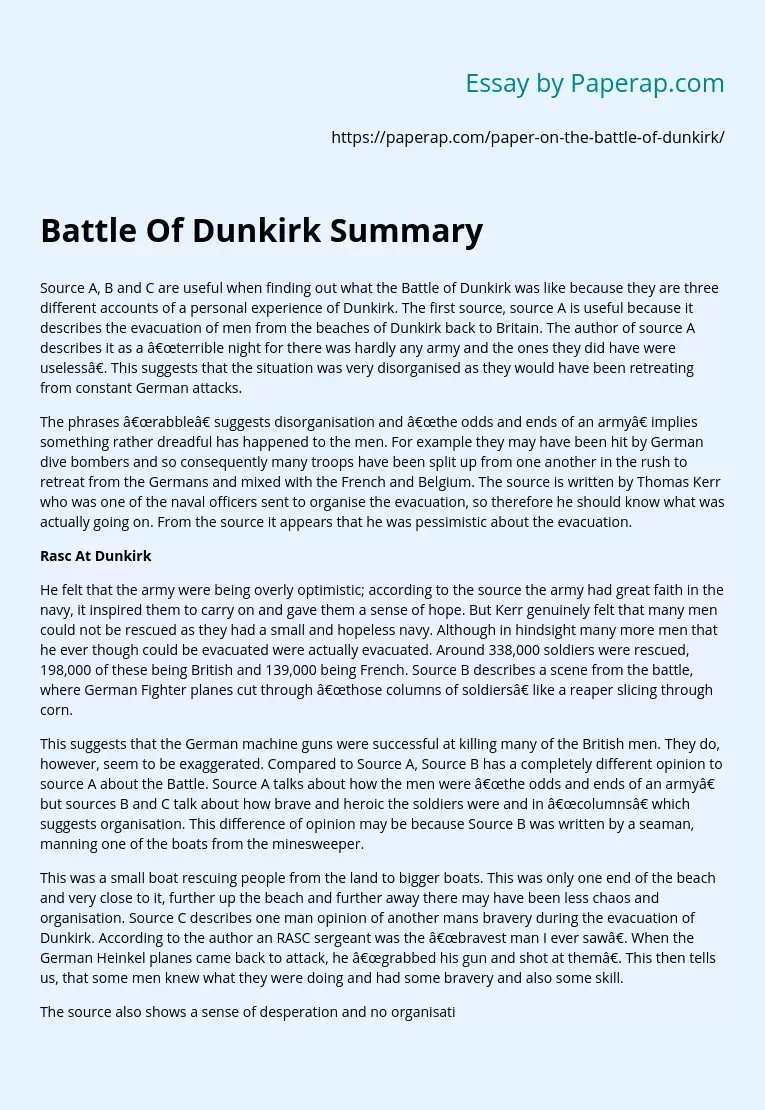Battle Of Dunkirk Summary
Source A, B and C are useful when finding out what the Battle of Dunkirk was like because they are three different accounts of a personal experience of Dunkirk. The first source, source A is useful because it describes the evacuation of men from the beaches of Dunkirk back to Britain. The author of source A describes it as a “terrible night for there was hardly any army and the ones they did have were useless”. This suggests that the situation was very disorganised as they would have been retreating from constant German attacks.
The phrases “rabble” suggests disorganisation and “the odds and ends of an army” implies something rather dreadful has happened to the men. For example they may have been hit by German dive bombers and so consequently many troops have been split up from one another in the rush to retreat from the Germans and mixed with the French and Belgium. The source is written by Thomas Kerr who was one of the naval officers sent to organise the evacuation, so therefore he should know what was actually going on.
From the source it appears that he was pessimistic about the evacuation.
Rasc At Dunkirk
He felt that the army were being overly optimistic; according to the source the army had great faith in the navy, it inspired them to carry on and gave them a sense of hope. But Kerr genuinely felt that many men could not be rescued as they had a small and hopeless navy.
Although in hindsight many more men that he ever though could be evacuated were actually evacuated. Around 338,000 soldiers were rescued, 198,000 of these being British and 139,000 being French. Source B describes a scene from the battle, where German Fighter planes cut through “those columns of soldiers” like a reaper slicing through corn.
This suggests that the German machine guns were successful at killing many of the British men. They do, however, seem to be exaggerated. Compared to Source A, Source B has a completely different opinion to source A about the Battle. Source A talks about how the men were “the odds and ends of an army” but sources B and C talk about how brave and heroic the soldiers were and in “columns” which suggests organisation. This difference of opinion may be because Source B was written by a seaman, manning one of the boats from the minesweeper.
This was a small boat rescuing people from the land to bigger boats. This was only one end of the beach and very close to it, further up the beach and further away there may have been less chaos and organisation. Source C describes one man opinion of another mans bravery during the evacuation of Dunkirk. According to the author an RASC sergeant was the “bravest man I ever saw”. When the German Heinkel planes came back to attack, he “grabbed his gun and shot at them”. This then tells us, that some men knew what they were doing and had some bravery and also some skill.
The source also shows a sense of desperation and no organisation though when it describes the RASC sergeant “blazing away at the Germans”. As it shows that there was panic and that he was lucky he had his gun to shoot at the Germans. Source C contradicts source A, as source A says that the men were completely useless, where as source C demonstrates the bravery of this one man although there was still a lack of organisation. In conclusion, none of the sources have dates with them, so they could have been written at anytime.
This makes them less reliable because if they were written after the time of the evacuation, it is likely details may have been forgotten or made up. All 3 sources were personal accounts written by men on board the ships. This is a disadvantage because there is no information from the men who were contributing in other parts of the country for example in the army or from the civilians. Also none of them were on the beach itself therefore wouldn’t know the position or attitudes of those men who were trying to escape of the beach.
Sources B and C are written by men who were working the ships, and were not trained officers, while source A was written by Commander Thomas Kerr, who was one of the naval officers sent to organise it. Therefore his opinion will be more reliable than the others as he was in a high up and respected position of the navy. Also he would therefore have had an overview of everything and had a better idea of the plans for the evacuation. What could make it even more reliable was if we had a German point of view in one of these sources, because they are all from British men therefore only have one country’s point of view of it all.
If there was a German point of view, the reader could learn about the evacuation from their knowledge and gain information as they may have had a different experience as they were the attackers. Although the sources are not useful because they are all only one mans opinion of the evacuation and it took place at only one place of the beach. For perhaps on another part of the beach they were lined up in columns with great organisation. Furthermore, this was only one moment out of the whole of the Battle which lasted from the 24th of May to the 4th June 1940, on other days it may have been worse or more unperturbed for the men.
Battle Of Dunkirk Summary. (2019, Dec 05). Retrieved from https://paperap.com/paper-on-the-battle-of-dunkirk/

